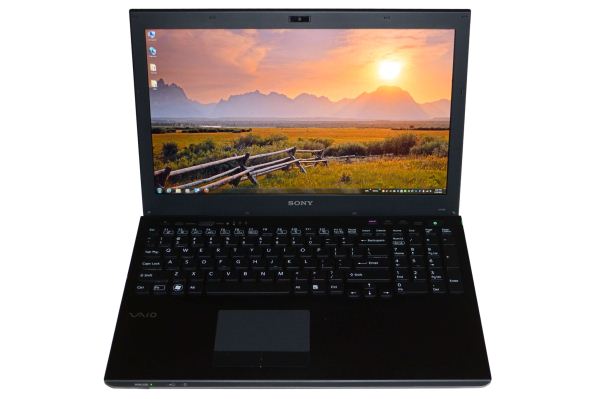Sony VAIO SE: An IPS Laptop for Under a Grand
by Jarred Walton on April 3, 2012 5:40 PM ESTConclusion: All About IPS
When all is said and done, there’s really one item that sets the VAIO SE apart from other laptops in its price range: the 1080p IPS display. You can find laptops with decent 1080p TN panels for about the same price (e.g. the Dell XPS 15z with 1080p upgrade), and you can certainly find a lot of faster laptops and notebooks, particularly if gaming is what you’re after. What you simply can’t find is a laptop with an IPS display that can still play games, all without breaking the bank.
The Sony VAIO SE isn’t a perfect laptop by any means. My biggest issues are build quality and the switchable graphics. I have no problem with the AMD HD graphics (at least the HD 6630M—the 6470M is pretty much DOA as far as I’m concerned), but AMD’s graphics switching technology just feels outdated. NVIDIA’s Optimus Technology switches on-the-fly between IGP and discrete graphics as needed, you can still get driver updates from NVIDIA and Intel without worrying about compatibility issues, and the single valid complaint I’ve seen against Optimus is that there’s (currently) no workable solution for Linux users. Given the driver compatibility issues I encountered with the VAIO SE (not to mention the VAIO CA we looked at in September), it’s pretty clear to me that any compatibility concerns with Optimus are only going to be worse if you’re looking at AMD’s alternatives.
Regarding build quality, I understand Sony’s point about going lightweight and thin, but I’m just not convinced that was the best decision. I would like to see a more rigid LCD/cover, and the hinge is quite loose for a new laptop—I can only imagine what it will feel like after a year or two of daily use. The main body of the laptop feels so much better than the display and hinge that I can’t believe these elements all exist on the same laptop. A solid feeling magnesium alloy frame is something I usually see with higher spec laptops (e.g. ThinkPads, Latitudes, and EliteBooks), and I would gladly sacrifice 0.05” of thickness to get a similar treatment for the top cover. I’d also like to see the hinge moved up so that it doesn’t block the sole exhaust port.
But really, if you’re not planning on playing a ton of games or running GPU intensive tasks, the only major concern that remains for me is the hinge and how it will hold up long-term. Counter that with a sub-$1000 price tag for a mainstream laptop that can do everything you’re likely to want, plus you get a 1080p IPS display. For everyone that looks at our laptop reviews and says, “Oh, please, not another pathetic 1366x768 display on a 15” laptop!”, the VAIO SE is for you.
Taking a quick look at the competition, here’s how things play out right now. Dell has their XPS 15z (which we reviewed here), and it’s priced similarly to the VAIO SE; get that with a 1080p display and Dell will currently charge $1300, but you can find a much better price elsewhere: $1080 for i7-2640M, 6GB RAM, 1080p LCD, plus all the other typical stuff; that’s a good deal. The VAIO SE display is better and it’s much easier to upgrade the HDD and memory than the 15z, but the 15z hinge seems better to me and Optimus trumps AMD manually switching graphics. Another potential option is the HP Envy series; the Envy 15 looks quite nice, and it has a faster HD 7690M GPU than the VAIO’s HD 6630M, but you lose the battery life offered by switchable graphics. It will also set you back $1250 with the 1080p “Radiance display” (which is reportedly the same IPS panel as the VAIO SE) and you “only” get an i5-2450M CPU. All told, I’d give the Envy 15 the edge in overall build quality, but it loses in form factor and battery life. The HP Envy 14 Spectre is another option, but it’s priced quite a bit higher (smaller means more expensive at this range), and you get a ULV CPU in the process. Finally, the only other “mainstream IPS” laptop we haven’t mentioned is the Lenovo ThinkPad X220; it’s smaller, it has a 1366x768 LCD, and the color gamut (and likely color issues) are similar to what you get from the VAIO SE. You also lose out on the discrete GPU and you pay $1250, so it’s basically better build quality and portability for more money and less performance.
 If you’re tired of lackluster TN panels and are looking for something better, I have no qualms about recommending the VAIO SE and its 1080p IPS display. The display is a big enough step in the right direction that it elevates the VAIO SE above most of its peers, provided you’re willing to live with a few compromises. I’ve been using the SE for the past month or so, doing plenty of typing and web surfing on it, and I’ve been very happy with the experience. You can read all of our quibbles about build quality and drivers, but at the end of the day if you just want a laptop that’s good for web browsing, office work, and multimedia—and you want IPS viewing angles without demanding perfect colors—the VAIO SE delivers. We’re awarding it our Bronze Editors’ Choice award for doing many things right (just like the Dell XPS 15z), and for hopefully shoving the laptop display market in the right direction.
If you’re tired of lackluster TN panels and are looking for something better, I have no qualms about recommending the VAIO SE and its 1080p IPS display. The display is a big enough step in the right direction that it elevates the VAIO SE above most of its peers, provided you’re willing to live with a few compromises. I’ve been using the SE for the past month or so, doing plenty of typing and web surfing on it, and I’ve been very happy with the experience. You can read all of our quibbles about build quality and drivers, but at the end of the day if you just want a laptop that’s good for web browsing, office work, and multimedia—and you want IPS viewing angles without demanding perfect colors—the VAIO SE delivers. We’re awarding it our Bronze Editors’ Choice award for doing many things right (just like the Dell XPS 15z), and for hopefully shoving the laptop display market in the right direction.
In fact, the only major reason to not consider the VAIO SE right now is the lateness of the hour. Ivy Bridge is right around the corner, and AMD and NVIDIA have just revamped their mobile GPU offerings. It’s a given that Sony will release a new variant of the VAIO SE at some point relatively soon. If they can address the few design flaws in the VAIO SE and give us something like a GeForce GT 640M with Optimus, that will be the laptop to beat come summer time.











59 Comments
View All Comments
ckryan - Tuesday, April 3, 2012 - link
This is some of the best news I've heard in a while.My perfect lappy would be something with a 14.1" IPS display at 16:10, somewhere in the neighborhood of 1440x900.
I don't think that is all that much to ask, and even eIPS is cool with me. Anything better than the awful TN panels out there.
I don't mind lower resolution as much in a laptop, at least to a certain extent. Windows 7 is ill-equipped to really make the most of high resolution displays in smaller screen sizes anyway.
peterfares - Tuesday, April 3, 2012 - link
"I don't mind lower resolution as much in a laptop, at least to a certain extent. Windows 7 is ill-equipped to really make the most of high resolution displays in smaller screen sizes anyway. "Why do people keep saying this? I've used Windows 7 with high DPI mode and it works flawlessly in my experience.
freedom4556 - Tuesday, April 3, 2012 - link
You must be nearly blind. It works terribly in my experience across many different displays, VGAs, and DPI settings. It's not Windows' fault, the apps just don't play nice with a DPI change.JarredWalton - Wednesday, April 4, 2012 - link
I'd say it's probably about 50-50 for apps playing well with the DPI setting. Most MS apps are fine, obviously, and the web works well for me. But there are definitely major applications where playing with the DPI setting causes issues. I have a 30" LCD and for a while I used the 125% DPI setting, but eventually I got sick of the glitches here and there and went back to the default scaling.Samus - Wednesday, April 4, 2012 - link
Windows 7 with big desktop icons and high dpi is no comparison to Windows xp's "stretch only supported GDI objects disproportionally to others".hemmy - Wednesday, April 4, 2012 - link
I think Windows 7 is great with high-res displays. Everything looks so crisp and small with tons of open screen space.laptop under - Saturday, October 7, 2017 - link
I totally agree with you. Visit <a href="https://laptopunder.net/">Laptop Under</a> if you are looking for best one.Machelios - Tuesday, April 3, 2012 - link
If only there was a hybrid hdd on this. Though, I think it is a bad decision to do only 1x4GB sticks. The performance will degrade in some applications. 2x2GB is better. I also wish there was an option without a CD Drive. The hinge problem is sad. It could have reached perfection.oh... and FIRST!
I know you guys will hate. I cannot wait.
kyuu - Tuesday, April 3, 2012 - link
Considering you're not actually first, I fully expect some hate as well. ;)But I agree, I wish manufacturers would start including an option for a hybrid HDD. The thing I hate most about buying a laptop is having to pay for the crappy HDD they stick in which I'm going to want to swap out first thing.
DigitalFreak - Tuesday, April 3, 2012 - link
"I know you guys will hate. I cannot wait."Being stupid is your fate. Now run along home and don't be late.